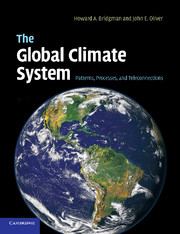Book contents
- Frontmatter
- Contents
- List of contributors
- Preface
- List of abbreviations
- 1 Introduction
- 2 Oscillations and teleconnections
- 3 Tropical climates
- 4 Middle-latitude climates
- 5 Climate of the polar realms
- 6 Post-glacial climatic change and variability
- 7 Urban impacts on climate
- 8 Human response to climate change
- 9 ESSAY: Model interpretation of climate signals: an application to Asian monsoon climate (Lau)
- 10 Conclusions and the future of climate research
- Other books on climatology and the climate system
- Index
- Plate section
- References
4 - Middle-latitude climates
Published online by Cambridge University Press: 05 June 2012
- Frontmatter
- Contents
- List of contributors
- Preface
- List of abbreviations
- 1 Introduction
- 2 Oscillations and teleconnections
- 3 Tropical climates
- 4 Middle-latitude climates
- 5 Climate of the polar realms
- 6 Post-glacial climatic change and variability
- 7 Urban impacts on climate
- 8 Human response to climate change
- 9 ESSAY: Model interpretation of climate signals: an application to Asian monsoon climate (Lau)
- 10 Conclusions and the future of climate research
- Other books on climatology and the climate system
- Index
- Plate section
- References
Summary
Introduction
In geographical terms, the middle-latitude climate zone is generally located between the poleward edges of the subtropical high pressure systems (approximately 35° N and S), and the beginnings of the polar circulations (approximate 60° N and S). For many years the middle-latitude climates were referred to as climates of the temperate zone. This proves a definitive misnomer, for while the zone contains some of the most equable of climates, it also has some of the most extreme. In the Northern Hemisphere (NH), the middle-latitude climates have some of the highest measure of continentality, an index that is essentially a measure of seasonal extremes.
This chapter examines various aspects of middle-latitude climates. It begins with an essay providing details of the development and significance of reanalysis. This recent analytical method draws upon a state-of-the-art data assimilation system to reprocess all past atmospheric environmental observations, combining them with short forecasts in order to derive the best estimate of the state and evolution of the environment. Since the statistical combination of the forecast and observations is denoted in operational applications as “analysis,” the new method is usually known as reanalysis. Thereafter, an account of selected aspects of middle-latitude climates of the NH is followed by a discussion of the much-neglected climates of the Southern Hemisphere (SH).
Information
- Type
- Chapter
- Information
- The Global Climate SystemPatterns, Processes, and Teleconnections, pp. 96 - 130Publisher: Cambridge University PressPrint publication year: 2006
